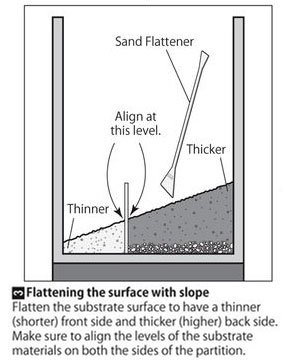Producing a Natural Feel with Cosmetic Sand Substrate built with Aqua Soil is topped with a thin layer of Powder Type Soil mainly in the foreground to add a final touch. With these are all natural sands and the effect of promoting the growth of aquatic plants cannot be expected. Rather, one of the purposes of using cosmetic sand is to create a foreground which can be easily maintained for a long period of time by making use of the cosmetic sand’s character of not being conducive to good growth of aquatic plants. A balanced look for the layout that is free of an oppressing feeling can be achieved by maintaining the foreground as thin as possible
On the other hand, the substrate made by spreading a thin layer of cosmetic sand can be maintained easily with no hassles of frequent trimming and replanting. From these facts, it can be seen that cosmetic sand is suitable for long-term maintenance. When using cosmetic sand for the foreground, the substrate needs to be clearly divided from the mid-ground and background (using Substrate & Soil) where aquatic plants are to be planted.
A convenient tool for this purpose is a partition made of cardboard. First, stand a strip of cardboard sheet pre-cut to the appropriate length along the pre-determined border line. At this time, the partition stands stably if it is supported by appropriately sized stones placed on both sides. that the partition will be securely in place. Once the partition has become stable, remove the stones supporting the partition. The stones left buried in the substrate may become an obstacle to the subsequent planting process. The point of dividing cosmetic sand and Aqua Soil is to make the cosmetic sand area in the front as thin as possible and make the Aqua Soil at the back thicker for easy planting. If there is a difference in the level of substrate materials on both the sides of the partition, the substrate may partially collapse and the substrate cannot be clearly divided into different sections. Make sure from by looking from at the line from a side angle that the levels of the substrate materials on both the sides of the partition are aligned and a straight slope is formed. If the slope is excessively gentle, it is suspected that the cosmetic layer is too thick or the Aqua soil layer is too thin. Dividing the substrate into sections is completed once the slope is confirmed to be well formed and the partition is removed. Subsequently, some stones serving as a soil divider are placed along the border line to prevent the soil from flowing onto the cosmetic sand portion.





Once the substrate has been built following the procedures stated above, water is poured into the tank up to the level where the substrate is barely submerged for easy planting of aquatic plants. In the case of a large tank like the ones installed in the Nature Aquarium Gallery, water is poured while swinging around the tip of the hose connected to the water tap like a sprinkler.
This method cannot be used for small tanks and in cases where the water cannot be poured using a hose. In this event, it is recommended to place a plastic bag on the substrate and pour the water from a plastic container slowly onto it. Whichever method you choose, the murky water accumulated in the tank should be drained and replaced with clear water after the planting is completed and before the tank is filled up with water. This work can be done effectively by draining the murky water with a hose while pouring in the same amount of clear water. The cause of this murky water is suspected to be the particles of fine soil from the substrate material such as Aqua soil and the dirt from unwashed cosmetic sand. The murky water left untreated can lead to prolonged cloudy or green water caused by organic matter and nitrogen contained in the soil particles and contaminants. It is important to ensure the water within the tank is clear before starting to run the filter. Some people run the filter before planting aquatic plants to have an established filter early.
However, this can result in prolonged cloudy or colored water due to agitated fine soil particles and humus leaching out of the exposed substrate. When setting up a new aquarium, it is advised to plant an adequate amount of aquatic plants once the substrate is completed so that the entire substrate surface will be covered in a short period of time. It is beneficial to resolve the cloudy or colored water problem as well as for easy maintenance.